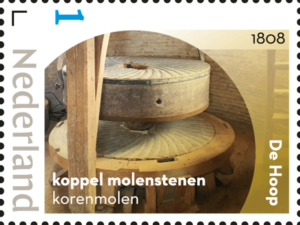[from a PostNL press release] [click on any of the pictures for larger versions]
De Hollandsche Molen’s 100th Anniversary
Date of issue: 15 May 2023
Format: sheet of 10 personalised stamps in 10 different designs,
denomination 1 for post weighing up to 20g with destinations within the Netherlands
Item number: 830044
Design: Bart de Haas, The Hague
In 2023, Vereniging De Hollandsche Molen [English: ‘The Dutch Windmill Association’] will celebrate its 100th anniversary by drawing attention to the multifaceted significance of 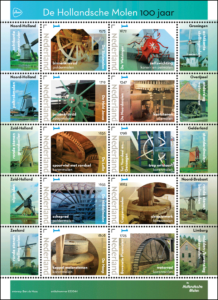 windmills in the Netherlands. The ten stamps depict various types of windmills from across the Netherlands, focussing on both construction and technology.
windmills in the Netherlands. The ten stamps depict various types of windmills from across the Netherlands, focussing on both construction and technology.
The stamps were designed by Bart de Haas from the Hague. A sheet of ten stamps costs €10.10.
‘De Hollandsche Molen, vereniging tot behoud van molens in Nederland’ [English: ‘The Dutch Windmill, association for the preservation of windmills in the Netherlands’] was founded on 15 May 1923 in Amsterdam. Initially, the association focused on preserving windmills in their economic function. After the World War II, the windmill lost its role as a means of production and the focus shifted to its scenic and historical value.
Thanks to the efforts of De Hollandsche Molen, hundreds of windmills have been 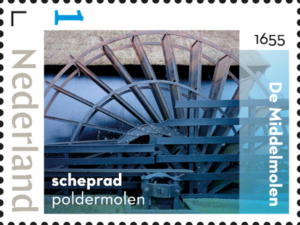 preserved and, in many cases, set in motion again. The association advises windmill owners, monitors the proper design of the windmill environment, raises awareness for the windmill and windmill preservation in society, promotes windmill ownership and mediates financial support for restoration and maintenance.
preserved and, in many cases, set in motion again. The association advises windmill owners, monitors the proper design of the windmill environment, raises awareness for the windmill and windmill preservation in society, promotes windmill ownership and mediates financial support for restoration and maintenance.
Some 10,000 mills were still in operation in the Netherlands in the 19th century. Of these, 1,200 remain, including polder windmills that can drain excess water from low-lying land (called “polders”) and industrial mills that can grind grain into 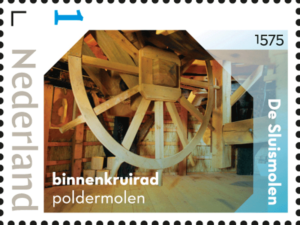 flour, saw wood into planks and press oil from seeds. These stamps feature examples of the following types of windmill: the octagonal internal turning mill, the octagonal scaffolding mill, the paltrok mill, the watermill (lower beam and middle/upper beam), the post mill, the wip mill, the round stone ground sailor, the round stone tower mill and the round stone scaffolding mill.
flour, saw wood into planks and press oil from seeds. These stamps feature examples of the following types of windmill: the octagonal internal turning mill, the octagonal scaffolding mill, the paltrok mill, the watermill (lower beam and middle/upper beam), the post mill, the wip mill, the round stone ground sailor, the round stone tower mill and the round stone scaffolding mill.
The names of the ten windmills featured on the stamp sheet are:
- De Sluismolen, 1575 (Alkmaar-Koedijk, Noord-Holland)
- De Wetsinger, 1872 (Wetsinge, Groningen)
- De Held Jozua, 1719 (Zaandam, Noord-Holland)
- De Noordmolen, 1347 (Ambt Delden, Overijssel)
- De Lelie, 1836 (Puttershoek, Zuid-Holland)
- Tot Voordeel en Genoegen, 1798 (Alphen aan de Maas, Gelderland)
- De Middelmolen, 1655 (Molenaarsgraaf, Zuid-Holland)
- Coppensmolen, 1883 (Zeeland, Noord-Brabant)
- De Hoop, 1808 (Wolphaartsdijk, Zeeland)
- Bovenste Plasmolen, 1725 (Plasmolen, Limburg)
The De Hollandsche Molen’s 100th anniversary stamps feature cut-outs from photos of 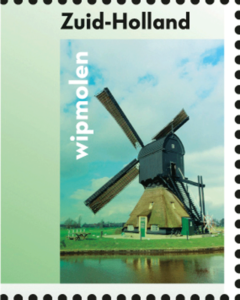 ten special windmill parts: five inner parts (inner cross wheel, edge runner stones, track wheel with pinion, sack hoist and a couple of mill stones) and five outer parts (self-turning sail, outer cross wheel, stage and tail beam, scoop wheel and water wheel). The tab next to each stamp [an example is shown on the left here] shows the mill in its entirety, with a colour gradient on the left from blue to green and on the right from blueish green to greyish green. A similar colour gradient is visible on the upper and lower sheet edges.
ten special windmill parts: five inner parts (inner cross wheel, edge runner stones, track wheel with pinion, sack hoist and a couple of mill stones) and five outer parts (self-turning sail, outer cross wheel, stage and tail beam, scoop wheel and water wheel). The tab next to each stamp [an example is shown on the left here] shows the mill in its entirety, with a colour gradient on the left from blue to green and on the right from blueish green to greyish green. A similar colour gradient is visible on the upper and lower sheet edges.
On the stamps, a geometric frame is placed over each detailed picture, referring to the shape of the windmill in question (octagonal, rectangular or round). Each stamp image was 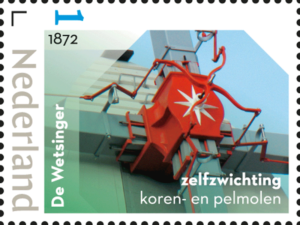 given a layer of colour with a relationship to the windmill’s function, for example yellow for a corn mill and blue for a water mill. The photo area outside of the frame is blurred to make the windmill part inside the frame stand out. Each stamp shows the name and function of the windmill, construction year and name of the windmill component. The tabs specify the windmill type and the province in which it is located.
given a layer of colour with a relationship to the windmill’s function, for example yellow for a corn mill and blue for a water mill. The photo area outside of the frame is blurred to make the windmill part inside the frame stand out. Each stamp shows the name and function of the windmill, construction year and name of the windmill component. The tabs specify the windmill type and the province in which it is located.
Windmills are a favourite subject for Dutch stamps. Previously published stamps featuring windmills include the graphic photos on the 1963 Summer Stamps, for example (designed 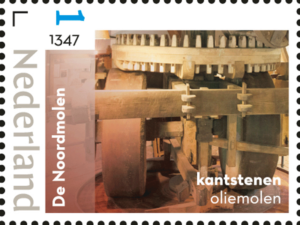 by Cor van Weele) and colourful illustrations on the 2013 Dutch Windmills stamp sheet (designed by Joost Veerkamp). Another stamp sheet in the Typically Dutch series was published last February, featuring an iconic illustration inspired by the Kinderdijk windmills (designed by Total Design).
by Cor van Weele) and colourful illustrations on the 2013 Dutch Windmills stamp sheet (designed by Joost Veerkamp). Another stamp sheet in the Typically Dutch series was published last February, featuring an iconic illustration inspired by the Kinderdijk windmills (designed by Total Design).
‘Windmills are typically Dutch, just like clogs, tulips and dykes. You can’t get more Dutch than that,’ says graphic designer Bart de Haas from The Hague, who was 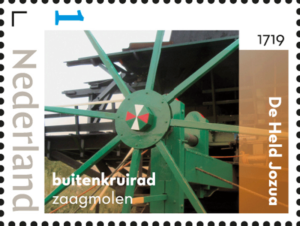 responsible for designing the De Hollandsche Molen’s 100th anniversary stamps. ‘We all know what a windmill looks like – the silhouettes in the landscape are imprinted in our collective memory. But we’re much less knowledgeable about the ingenious operation behind the various types of windmill. These latest windmill stamps therefore focus on the technology, featuring photos of the typical parts of a windmill. I also wanted to show a wide variety of windmill types, with as little overlap as possible. The
responsible for designing the De Hollandsche Molen’s 100th anniversary stamps. ‘We all know what a windmill looks like – the silhouettes in the landscape are imprinted in our collective memory. But we’re much less knowledgeable about the ingenious operation behind the various types of windmill. These latest windmill stamps therefore focus on the technology, featuring photos of the typical parts of a windmill. I also wanted to show a wide variety of windmill types, with as little overlap as possible. The 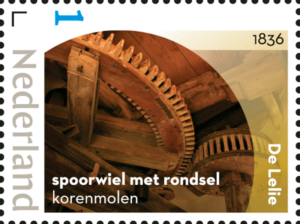 proportions on the stamp sheet more or less match reality. For example, there are many more windmills than water mills in the Netherlands and more corn mills than polder mills.’
proportions on the stamp sheet more or less match reality. For example, there are many more windmills than water mills in the Netherlands and more corn mills than polder mills.’
Of the ten parts, five come from inside the windmill and five come from the outside. The indoor and outdoor shots are staggered diagonally across the stamp sheet from top to bottom. Some of the parts were an obvious choice, such as the mill stones at De Hoop corn mill, the water wheel at De Bovenste Plasmolen and the edge runner stones at oil mill De Noordmolen.
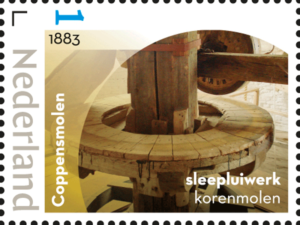 The photos used were taken by no less than twelve different photographers. ‘They’re all passionate windmill enthusiasts,’ says De Haas. He edited all of the pictures to make the more suitable for the stamps.
The photos used were taken by no less than twelve different photographers. ‘They’re all passionate windmill enthusiasts,’ says De Haas. He edited all of the pictures to make the more suitable for the stamps.
The stamps are available while stocks last at www.postnl.nl/bijzondere-postzegels [in Dutch]. The stamps can also be ordered by phone from the Collect Club customer service on telephone number +31 (0)88 868 99 00. The validity period is indefinite. The denomination on the stamp is ‘Nederland 1’, for standard letters 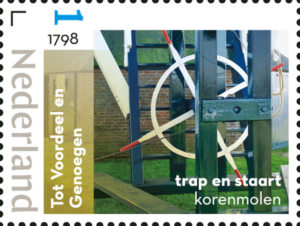 weighing up to 20g sent to an address within the Netherlands.
weighing up to 20g sent to an address within the Netherlands.
Technical Details:
Stamp size: 30 x 40mm (wxh):
Sheet size: 170 x 122 mm (wxh)
Paper: Normal with phosphor print
Gum: Gummed
Printing technique: Offset
Printing colours: Cyan, magenta, yellow, black
Edition: 5,000 sheets
Appearance: Sheet containing 10 personal stamps in 10 different designs
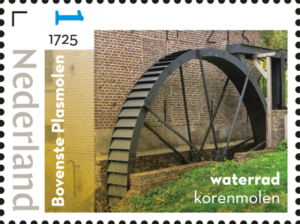 Denomination: Denomination 1 for post weighing up to 20g with destinations within the Netherlands
Denomination: Denomination 1 for post weighing up to 20g with destinations within the Netherlands
Design: Bart de Haas, The Hague
Photography: William Bouter, Martin E. van Doornik, Piet Glasbergen, Matthieu Hoogduin, Tony Hop, Bernd Käding, Frank Moerland, Marcel van Nies, Harmannus Noot, Dirk Prince, Martijn Scholtens, Jesse in ’t Veld, J. Vingerhoed, Pieter Zuijkerbuijk
Item number: 830044 